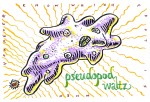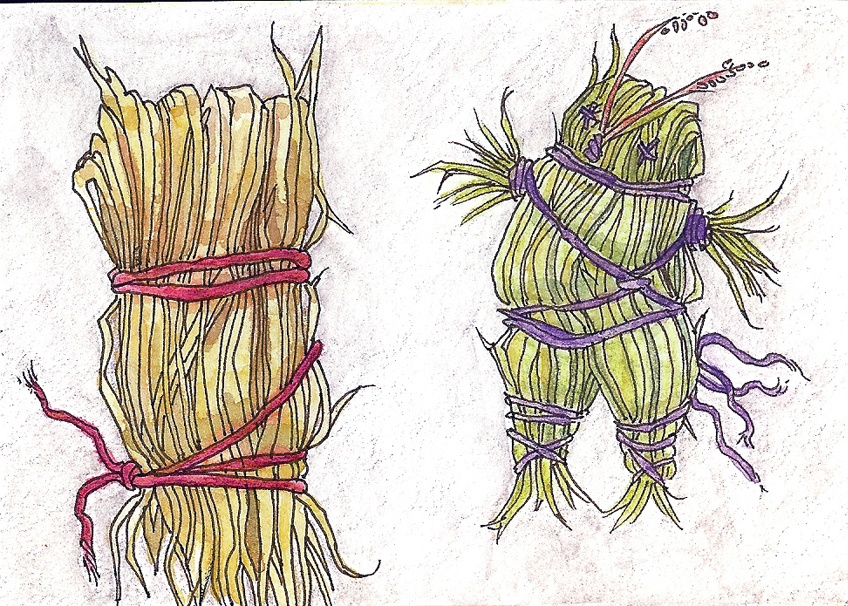Straw Owls in the Ganskopf Special Collection
 (This is the sixth installment of a series. Read the others chronologically by clicking these links: first, second, third, fourth, fifth)
(This is the sixth installment of a series. Read the others chronologically by clicking these links: first, second, third, fourth, fifth)
Within a month, a letter from Professor Harrower had arrived requiring me to return to the Ganskopf Institute to draw another selection of mysterious “Owl Fetishes” from the Institute’s diverse collection. The project was still making little sense to me, because of its sporadic and leisurely timing, the odd, anachronistic communication style of my employer, and the curious nature of the pieces themselves. But the money was welcome – a freelance technical artist’s pay can be unreliable at times – so of course, when summoned, I went.
And at last, after prehistoric pebbles, pine-bark souvenirs, Attic coins, and other miscellany, the Special Collections librarian Miss Laguna had brought out something really odd – two items that conformed a little more closely to my expectations of what “mystery relics” ought to be. It was a pair of strange straw owl “dolls” – really just owl-like shapes about 8 and 10 inches tall – bound with colored twine and smelling a bit mildewy, like an old barn. One was an extremely rudimentary representation, faceless, and owlish only because of its proportions and an aura of eyeless alertness. This was due to the presence, perhaps deliberate, of “ears” at the folded axis of the straw representing  its head. The other, held together with a faded purple cord and made with a greener straw, was owly and anthropomorphic, with stunted wing-like “arms” jutting out to the side, and thick-thighed legs. It had more of a face, with eyes and beak stitched on in the purple cord, and straw blossoms jutting up in a V to indicate “horns”. The stitched eyes looked blank, and its slightly torqued posture gave it the impression of motion, but also made it look impaired somehow, damaged: the effect was unsettling. Equally disturbing was the fact that both owls appeared blind – not the standard presentation of open-eyed owliness, especially common in folk-art. Neither figure stood upright, but appeared to be meant to either hang, or simply lie flat.
its head. The other, held together with a faded purple cord and made with a greener straw, was owly and anthropomorphic, with stunted wing-like “arms” jutting out to the side, and thick-thighed legs. It had more of a face, with eyes and beak stitched on in the purple cord, and straw blossoms jutting up in a V to indicate “horns”. The stitched eyes looked blank, and its slightly torqued posture gave it the impression of motion, but also made it look impaired somehow, damaged: the effect was unsettling. Equally disturbing was the fact that both owls appeared blind – not the standard presentation of open-eyed owliness, especially common in folk-art. Neither figure stood upright, but appeared to be meant to either hang, or simply lie flat.
Their straw was spotted and stained, and the pieces looked fragile; in fact, each had shed a few crumbs and fragments of dry fiber onto the black velvet pillow. Miss Laguna allowed the crumbs to lie there, and gently passing a non-latex purple-gloved hand above them, explained that all the bits and pieces would have to go back in the drawer with the objects after I was through. She set them down a little farther from me than usual, then looked at me and said seriously, “Please, I must ask you to not breathe on them. They suffer in the presence of moisture.” This earnest instruction, together with the moldy smell of old straw, had the instant effect of making me need to sneeze, which I tried to suppress as I nodded my head and began to set up my gear with watering eyes.
It was going to take a long time: my sketches needed to accurately reflect the number and placement of each fiber of straw, and also I wanted to be especially sure to capture the creepiness of the purple-twined figure’s posture. I’d forgotten my watch, so I glanced up  through the Special Collection’s front glass to check the wall-clock in the main reading room. As I did, I noticed another patron: once again, it was the sleek Dr. Danneru. He was talking on a cell phone, nonchalantly stationed right under a sign plainly forbidding cell phone use. When he saw me looking, he turned away as if for privacy, although I couldn’t hear him through the glass. The rules just don’t apply to some people, I thought, and turned back to my work.
through the Special Collection’s front glass to check the wall-clock in the main reading room. As I did, I noticed another patron: once again, it was the sleek Dr. Danneru. He was talking on a cell phone, nonchalantly stationed right under a sign plainly forbidding cell phone use. When he saw me looking, he turned away as if for privacy, although I couldn’t hear him through the glass. The rules just don’t apply to some people, I thought, and turned back to my work.
The sketches did take a long time. Miss Laguna, despite her concern over the decomposing straw pieces I was drawing, left me largely on my own. This was in order to see attentively to the needs of her other patron, who had finished his phone call, passed through the metal detector and past the security guard into Special Collections, and was currently viewing a Ganskopf item at the table behind me. I was not surprised to see a steaming mug held in one of his hands as if it were too hot to drink, but too coveted to put down. The grassy – and pricey – aroma of green Rooibos tea reached me where I sat, mildly irked by the scholar’s flagrantly bootlegged luxury beverage, when I had been instructed to not even breathe.
I was not surprised to see a steaming mug held in one of his hands as if it were too hot to drink, but too coveted to put down. The grassy – and pricey – aroma of green Rooibos tea reached me where I sat, mildly irked by the scholar’s flagrantly bootlegged luxury beverage, when I had been instructed to not even breathe.
A couple of hours passed in the near silence of the Special Collections room. By then my back had stiffened up from leaning across the table to get closer to the straw figures, and it was getting dark outside. I found it necessary to stand up to straighten out: I extended my arms over head, cracked my neck, and twisted my torso right, then left. Then right again, quickly checking behind me: Dr. Danneru had disappeared – perhaps to fetch fresh tea – leaving his notes on the table, along with the black cushion and his study object. He must have left quietly, because I’d never noticed. Miss Laguna was nowhere in sight, either. As if merely stretching my legs, I casually sauntered over to the other table, curious to see if the scholar was studying an owl I’d already drawn. He wasn’t. I stared.
Now, there was a “mystery relic”…

this little drama/mystery is absolutely fascinating!
[…] This is the seventh installment in a series. Click here to read the first, second, third, fourth, fifth, sixth. […]